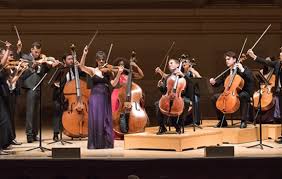
Music Stitches Together Our Social Fabric....
Share
Music stitches together our social fabric in many ways.
Those who enjoy bluegrass, ska, funk or even the Grateful Dead share a common language within their genre. And, yes, whenever strangers gather to listen to the same music, they bop their heads to the beat, tap their fingers and swing their feet to the rhythm together.
And it turns out, when music plays, we share the experience of melody, harmony and rhythm at a much more basic, personal level. For instance, when Stanford University researchers scanned the inner workings of the noggins of people listening to classical music they hadn’t heard before, the researchers identified strikingly similar patterns of activity across the same network of brain structures in all study participants.
The areas of the brain that grooved in common to the tunes included those involved in movement planning, memory and attention.
The results show for the first time that, despite all of our varied and individual differences in musical experiences and preferences, music — or classical music, anyway — elicits a near-identical brain-activity pattern across individuals. The consistent response indicates that music has played a key role in human social development throughout our history and pre-history.
Today, we spend a lot of time listening to music — often in groups, and often in conjunction with synchronized movement and dance. These brain patterns tell us our species has been doing so for a very, very long time, and that music has helped create human community at the most fundamental level.
Another study confirms music’s communal effects, this time on singers. As with all musicians, singers who perform together must pay attention to each other, to the conductor and to the sounds being created around them. However, researchers in Germany have found that that attuned-ness goes even deeper in people who sing in choirs.
The scientists found that when people sing choral music together, their heartbeats synchronize, so that choir members’ pulses increase and decrease in unison as the music progresses.
The music’s melody and structure influence the cardiac activity by imposing regular, calm, deep breathing on all the singers, similar to deep breathing in yoga. Singing requires long, controlled exhalations while phrases of words and notes are sung, and quick, deep inhalations in between.
The exhalations regulate activity within humans’ vagus nerve. This long nerve runs from the brain through the torso and is involved in controlling heartbeat, blood pressure, sweating and numerous other bodily functions we normally pay attention to only when something goes wrong. The vagus nerve also helps control the vocal cords and production of some hormones, including some that regulate mood and stress.
To be able to sing long musical phrases in unison, choir members must breathe in unison. And that, in turn, means their heart rates and all the other downstream physiological effects also change in unison.
The researchers say they want to investigate whether the biological synchronizing of choral singers’ heartbeats also strengthens the singers’ ability to collaborate and co-operate with others.
That ability is essential in people who sing together in choirs.
Or perform instrumental jazz together.
Or organize a festival together.
Or build a community together.
- See more at: http://www.timescolonist.com/opinion/columnists/monique-keiran-music-brings-us-together-in-multiple-ways-1.1138464#sthash.Xl8EXzZf.dpuf
